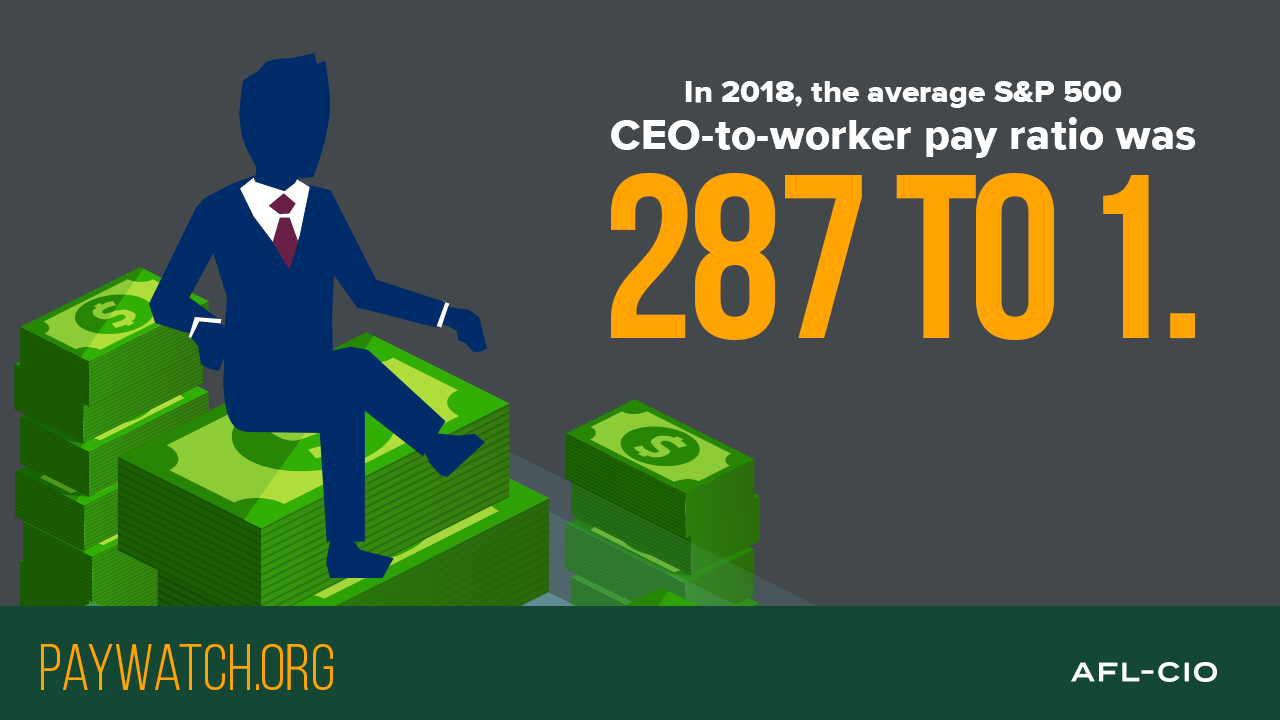
The AFL-CIO this week released its annual Executive Paywatch report. AFL-CIO Secretary-Treasurer Liz Shuler (IBEW) discussed the federation’s findings during a call with reporters, highlighting the continuing pay inequity between workers and CEOs, discussing the impact of the Trump administration’s tax law on executive compensation and pointing out some of the worst offenders among major corporations.
About the report, Shuler said:
Here’s the key point: Even with that extra cash, wages are not keeping up with inflation. The average worker isn’t making enough to cover rent for a two-bedroom apartment in 15 of the largest cities across the country! Meanwhile, 40% of hourly workers have nothing saved up for an emergency, while 75% have less than $500.
We know this equality gap isn’t new. Over the past decade, the average S&P 500 CEO’s pay increased by more than $5 million, while the average worker only saw an increase of less than $800 a year. Not surprisingly, the CEO-to-worker pay ratio remains high: 287 to 1.I’ll repeat that: 287 to 1. Meaning the average CEO earns 287 times what an average employee earns.
This disparity represents a fundamental problem with our economy: Productivity and corporate profits are through the roof, but wages for working people are flat—and staying flat.
Here are 12 key findings from the report that illustrate Shuler's words:
- The average S&P 500 company CEO-to-worker pay ratio was 287 to 1.
- In 2018, CEOs of S&P 500 companies received, on average, $14.5 million in total compensation.
- This year marks the first where nearly all S&P 500 companies have disclosed the pay ratio between their CEO and median employee. This important disclosure did not come easy. Major corporations and industry groups lobbied long and hard to hide this valuable information from shareholders and the general public.
- The average S&P 500 CEO’s pay has increased by $5.2 million over the past 10 years, a CEO pay increase of more than half a million dollars annually.
- The average U.S. rank-and-file worker’s pay has increased only $7,858 over the past 10 years, a pay increase of less than $800 per year annually.
- Sixty of the largest U.S. companies paid $0 in income taxes in 2018 despite being profitable, including corporations like Amazon, Netflix, Delta and General Motors.
- Corporate income tax collections fell by $93 million in fiscal year 2018 after the passage of the 2017 Republican tax cut, a 31% drop.
- Stock buybacks by the top 15 U.S. companies with the largest holdings of cash abroad spiked dramatically after the 2017 corporate tax cut on overseas profits. Ten of the largest U.S. companies—Amgen, Apple, Bank of America, Cisco Systems, Citigroup, Facebook, JP Morgan, Microsoft, Oracle and Wells Fargo—combined to buy back more than a quarter-billion dollars of their own stocks in 2018. Not surprisingly, the average CEO pay for these companies increased dramatically as well.
- Tesla CEO Elon Musk was the highest paid CEO in 2018. His compensation package was estimated to be worth nearly $2.3 billion, although many doubt that he can achieve his performance targets. Tesla had the highest pay ratio out of all companies: 40,668 to 1.
- On the other hand, 14 companies paid their CEO one dollar or less in 2018.
- The highest pay ratio for S&P 500 companies was at clothing retailer Gap, where the pay ratio was 3,566 to 1 and the median employee earned $5,831 (a part-time sales associate).
- The lowest pay ratio in the S&P 500 was at Alphabet (parent of Google), where its co-founder and CEO Larry Page received just $1 compared to its median employee pay of $246,804.
In conclusion, Shuler said:
Bottom line: For too long, corporate greed and rigged economic rules have created a relentlessly growing pay gap between CEOs and the rest of us. It’s why everything from a college education to retirement security to gas prices are getting harder and harder for people to afford. We see it every day in communities across the country. And that must change.
Our economy works best when consumers have money to spend. That means raising wages for workers and reining in out-of-control executive pay. This year’s report is a stark reminder that working people must use our collective voice to form bigger, stronger unions and rewrite the economic rules once and for all.


